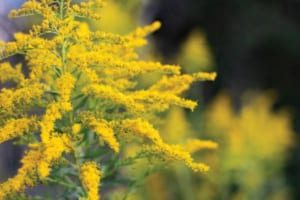Goldenrod solidago is a genus of over 100 species of flowering plants in the Asteraceae (Aster) family.

Solidago comes from the Latin word soldago, meaning to make whole, or to heal.
If Goldenrod and Ragweed were in a police lineup, the results wouldn’t fare well for Goldenrod, as it’s blamed for fall allergies more times than not. Once accused, innocence is sometimes hard to prove, but Goldenrod crusaders proclaim you cannot have allergies caused from the plant. Goldenrod attracts bees and butterflies, wasps and flies.
It’s a perennial, mostly native to North America, but now grown worldwide. Germany and China have it listed as an invasive species, but maybe they don’t know about the health benefits. Native Americans used to chew the leaves to alleviate painful toothaches. Other medicinal uses have been as a kidney/urinary tract tonic to help with bacterial infections and kidney stones.
The flowers can be used as an edible garnish and the leaves can be dried for making tea, or cooked fresh like any greens. Have you ever heard anyone say they’re going to go home and cook up a mess of Goldenrod? Me neither.
Speaking of medicinal uses, in laboratory studies using rodents, Goldenrod has been found useful for weight control, cancer prevention, anti-aging and heart health.
Great. Just what we need. Minnie and Mickey Mouse look-a-likes that have healthy hearts, won’t contract cancer, wear bikinis and never get old.
A bit of trivia: Did you know the tires on the Model T given to Thomas Edison by Henry Ford were made from Goldenrod? Edison cultivated a process to maximize the natural content of rubber found in Goldenrod. But wait, there’s more. Henry Ford and George Washington Carver worked alongside each other, experimenting with different crops and found a way to make rubber from Goldenrod. Wouldn’t you have liked to have been a fly on that Goldenrod?
October is here, and Goldenrod can be seen blooming until frost. Although some start blooming in late July, it has been said you can count the days to the first frost by watching the blooms. The day Goldenrod comes into full bloom means it’s six weeks until the first frost.
What a noble little plant. Often misjudged, but gives so much. We can learn a lot from Goldenrod.
Brought to you by The Accidental Gardener
Laurel Magazine, October 2019 issue




